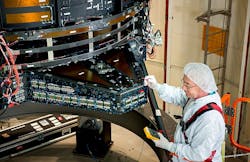NASA taps Teledyne for space-qualified electro-optical sensor for WFIRST space telescope
GREENBELT, Md. – Space observation experts at the NASA Goddard Space Flight Center in Greenbelt, Md., needed space-qualified shortwave infrared (SWIR) electro-opticalsensor chip assemblies for the Wide-Field Infrared Survey Telescope (WFIRST). They found their solution from Teledyne Scientific & Imaging LLC in Camarillo, Calif.
NASA has announced a $23 million contract to Teledyne to provide 72 SWIR sensor chip assemblies for the WFIRST space flight focal plane assembly.
Teledyne also will perform a warm functional test and cold functional screen test for final space flight sensor chip assembly testing and performance requirements verification.
Teledyne is the only company able to manufacture the SWIR sensor chip assemblies to WFIRST mission requirements, NASA officials say, adding that Teledyne is providing other hardware and infrastructure to the WFIRST project NASA previously has awarded several contracts to Teledyne for similar sensor chip assemblies on the WFIRST.
Teledyne is providing 18 of the company's H4RG-10 arrays in the focal plane assembly of the WFIRST spacecraft, which is scheduled to launch in the mid 2020s. The H4RG-10 offers more than 300 million pixels, and will be the largest infrared focal plane operating in space when it launches, Teledyne officials say. Teledyne also is building the visible light detectors for the WFIRST coronograph instrument.
Related: Article headline goes here
WFIRST will have nearly 300 times as many pixels as the infrared camera of the Hubble Space Telescope, and will be able to take images with 100 times the field of view of Hubble. The large field of view enables WFIRST to survey large areas of the sky to measure the effects of dark matter and dark energy on the distribution of galaxies in the universe.
On this 29-month contract for WFIRST SWIR sensor chip assemblies, Teledyne will be finished by October 2020. For more information contact Teledyne Scientific & Imaging online at www.teledyne-si.com, or the NASA Goddard Space Flight Center at www.nasa.gov/goddard.
Ready to make a purchase? Search the Military & Aerospace Electronics Buyer's Guide for companies, new products, press releases, and videos
